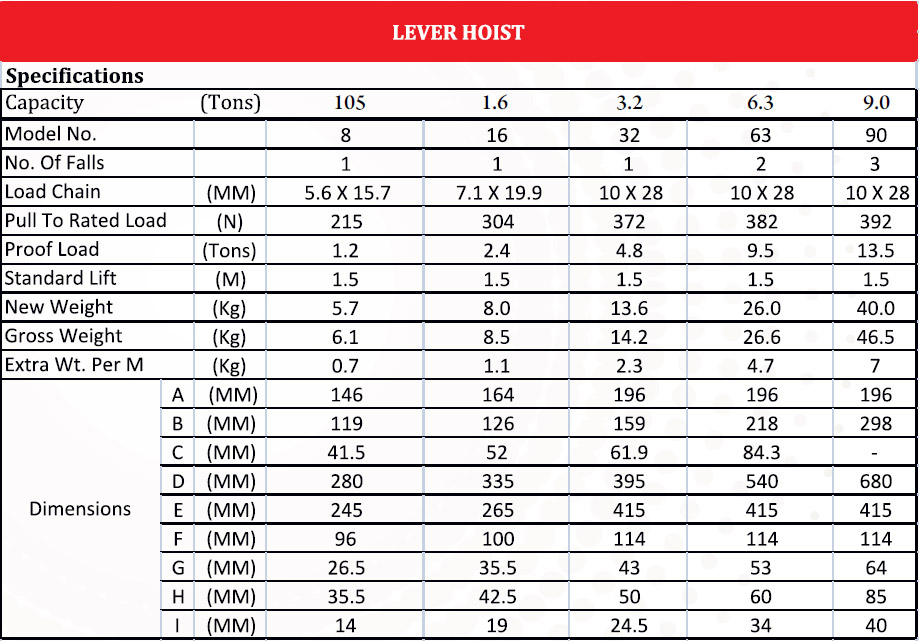LEVER HOIST (HEAVY DUTY)
Standard Features
- Very Robust But Light Weight
- Zinc Plated Grade 100 Load Chain
- Each Lever Hoist is tasted 1.5 times of the rated capacity
- Zinc Plated Grade 100 Load Chain
- Very Robust But Light Weight
- Zinc Plated Grade 100 Load Chain
- Very Robust But Light Weight
- Zinc Plated Grade 100 Load Chain


Whitte Horse chain blocks are designed with several safety features to ensure reliable and secure lifting operations:
- Double Pawl and Double Guide Rollers: These enhance performance, safety, and reliability by ensuring smooth operation and preventing accidental slippage.
- Wide Throat Drop Forged Hooks: These hooks are designed to bend slowly under overload, providing a visual warning before failure.
- Spur Gear Efficiency: Reduces operator effort and ensures efficient lifting.
- Safety Factor: Whitte Horse chain blocks have a safety factor of 4 times the rated capacity, ensuring a significant margin of safety.
- Load Chain Material: Made from alloy steel grade 80 according to ISO 3077, providing high strength and durability.
- Compliance with Standards: Meets all pertinent world standards, ensuring quality and reliability.
These features make Whitte Horse chain blocks a reliable choice for heavy-duty lifting tasks.
dos and dont for chain block
Here are some important dos and don’ts for using chain blocks safely:
Do’s:
- Inspect Before Use: Always inspect the chain block and accessories before use and before placing them into storage.
- Use Safety Devices: For top hook suspension, use hooks fitted with safety catches or mouse the hook to ensure the support fits freely into the seat of the hook.
- Proper Slinging: Adopt safe slinging practices and follow the instructions for the safe use of the equipment.
- Correct Trolley Setup: Ensure the trolley is correctly set for the beam width.
- Check Load Capacity: Verify that the bottom hook will reach its lowest point without running the chain fully out.
- Store Properly: Store chain blocks in a dry, clean area to avoid corrosion.
Don’ts:
- Don’t Expose to Contaminants: Avoid exposing chain blocks to chemicals, particularly acids, without consulting the supplier.
- Don’t Use Faulty Equipment: Never use chain blocks with visible damage or defects.
- Don’t Force Operation: Don’t use undue effort to force the block to operate.
- Don’t Drag or Drop: Never throw, drop, or drag a chain block.
- Don’t Allow Oil/Grease on Brakes: Avoid letting oil or grease come into contact with the brake.
- Don’t Expose to Elements: Don’t expose chain blocks directly to elements like water spray or steam without consulting the supplier.
Following these guidelines will help ensure safe and effective use of chain blocks.
Maintainace for chain block
Maintaining your chain block is crucial for ensuring its longevity and safe operation. Here are some key maintenance tips:
Regular Inspections
- Visual Inspection: Check for any visible signs of wear, damage, or corrosion on the chain block and its components.
- Check for Twists or Kinks: Ensure the chain is properly seated in the sheaves and not twisted or kinked.
- Inspect Hooks and Attachments: Look for any cracks, bends, or wear on hooks and other attachments.
Cleaning
- Remove Dirt and Debris: Clean the chain block regularly to remove dirt, grease, and debris that can cause wear and tear.
- Lubrication: Apply appropriate lubricant to moving parts to ensure smooth operation and prevent rust.
Usage
- Proper Usage: Always use the chain block within its rated capacity and follow the manufacturer’s guidelines.
- Avoid Overloading: Never exceed the load limit to prevent damage and ensure safety.
Storage
- Dry Storage: Store the chain block in a dry, clean area to prevent rust and corrosion.
- Proper Handling: Handle the chain block with care to avoid dropping or dragging it on the ground.
Documentation
Maintenance Records: Keep a record of all inspections, maintenance activities, and repairs

